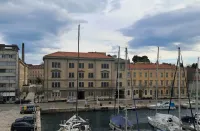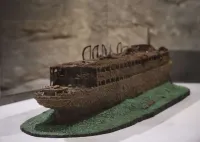
Maritime collection Gallerion
Maritime collection "Gallerion" at a new location
Visit “Gallerion” at its new location with a breathtaking view of Pula Bay – the former main naval port of the Habsburg Monarchy – and discover the fascinating story of the region's naval heritage. Explore a rich collection of ship, submarine, and seaplane models, original souvenirs from distant expeditions, and authentic artefacts from naval history. Don't miss the chance to be part of the beginning of the story of the future Naval Museum of Pula, as starting from 2026, the collection will gradually expand to 3,000 m2.
NEW LOCATION - RIVA 12
Gallerion Exhibition Price List
| Individual | Price |
|---|---|
| Adults | 8,00€ |
| Students and seniors 60+ | 5,00€ |
| Children 7 to 18 years old | 5,00€ |
| Children 3 to 6 years old | 3,00€ |
| Children under 3 | Free entrance |
Ticket prices are subject to change.
Individuals with disabilities are granted a 50% discount on the standard ticket price when purchasing at the entrance.
For terms for group visits (preschools, schools, adults) of over 15 people, please contact us by email at booking@aquarium.hr.
Working hours
| Working hours | Last entry |
|---|---|
| Every day
9 - 17 h | 16 h |
HISTORY OF THE BUILDING
The building is located in the wider area of the historic core of the city of Pula. It was constructed in 1930 as the administrative headquarters of the neighbouring tobacco factory. Since 1947, a textile factory has been operating there, which remained active under the name 'Arena Trikotaža' until 2014. In addition to its industrial value, the building holds significant socio-cultural importance as a workplace for many generations and as a part of the local community’s collective memory.
ABOUT THE COLLECTION
Gallerion is a unique collection developed over a period of 40 years, primarily dedicated to the Imperial and Royal Navy of the Habsburg Monarchy and the more illustrious era of Pula as the main naval war port of the time.
It includes over 30 large and 300 smaller models of sailing ships, warships, submarines, uniforms, weapons, artworks, and other exhibits.
DID YOU KNOW?
Austro-Ugarska ratna flota nije služila samo u vojne svrhe, već je imala i znanstvenu ulogu. Ekspedicije austrougarske ratne mornarice intenzivirale su obuku posade i bile prisutne na gotovo svim svjetskim morima, pružajući pritom priliku za stjecanje znanstvenih spoznaja.
Nadvojvoda Ferdinand Maksimilijan, zapovjednik Ratne mornarice, poboljšao je obrazovanje časnika i posada organiziranjem redovitih prekooceanskih putovanja ratnih brodova. Admiral Wilhelm von Tegetthoff 1869. godine donio je odluku da se nakon četverogodišnjeg školovanja na riječkoj Mornaričkoj akademiji za pomorske kadete svake godine redovito organiziraju prekooceanska instrukcijska putovanja.
Pula was among the world’s major naval bases, while the Austro-Hungarian Navy ranked as the seventh naval power in the world, with the largest warships ever built in this region.






























